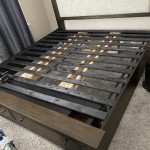How To Make Raised Beds On Sloped Roof
Raised beds can be a great way to grow vegetables and flowers in areas with limited space or poor soil conditions. They are also a good option for people who want to be able to garden at a comfortable height. If you have a sloped roof, you can still build raised beds by following these steps:
- Choose a site. The first step is to choose a site for your raised beds. The site should be well-drained and receive at least six hours of sunlight per day. If the slope is too steep, you may need to level it out before you can build your raised beds.
- Build the frame. The next step is to build the frame for your raised beds. The frame can be made from a variety of materials, such as wood, metal, or concrete blocks. If you are using wood, be sure to use pressure-treated lumber that is resistant to rot and decay.
- Line the frame. Once the frame is built, you need to line it with a material that will prevent the soil from leaking out. You can use a variety of materials for this purpose, such as landscaping fabric, plastic sheeting, or old carpet.
- Fill the beds. The next step is to fill the raised beds with soil. You can use a variety of soil types, but a good mix of topsoil, compost, and sand is ideal. Be sure to fill the beds to within a few inches of the top.
- Plant your vegetables or flowers. Once the raised beds are filled with soil, you can plant your vegetables or flowers. Be sure to choose plants that are suitable for the amount of sunlight and water that your beds will receive.
Here are some additional tips for building raised beds on a sloped roof:
- Use retaining walls. If the slope is very steep, you may need to build retaining walls to keep the soil in place. Retaining walls can be made from a variety of materials, such as wood, stone, or concrete blocks.
- Add drainage holes. Be sure to add drainage holes to the bottom of your raised beds. This will help to prevent the soil from becoming waterlogged.
- Water regularly. Raised beds on a sloped roof will need to be watered more frequently than raised beds on level ground. This is because the water will tend to run off the slope more quickly.
- Fertilize regularly. Raised beds on a sloped roof will also need to be fertilized more frequently than raised beds on level ground. This is because the nutrients in the soil will be more easily leached out by the water.
With a little planning and effort, you can build beautiful and productive raised beds on a sloped roof. These beds will allow you to grow a variety of vegetables and flowers, even if you have limited space or poor soil conditions.

How To Build Raised Garden Beds On A Slope Primal Palate Paleo Recipes Building Planter Boxes

Builddirect Flooring Decking Siding Roofing And More Building A Raised Garden Sloped

Grow Up Build An Edible Rooftop Garden Therapy

Terraced Vegetable Garden Roti N Rice

Sloped Green Roofs Waterproof

Guide To Rooftop Gardens Garden Design

Creative Vegetable Gardener How To Make An Easy Raised Garden Bed For Your Vegetables

These Bricks Make Building Raised Garden Beds Simple Wirecutter

Green Roof Construction How To Make A

These Bricks Make Building Raised Garden Beds Simple Wirecutter







